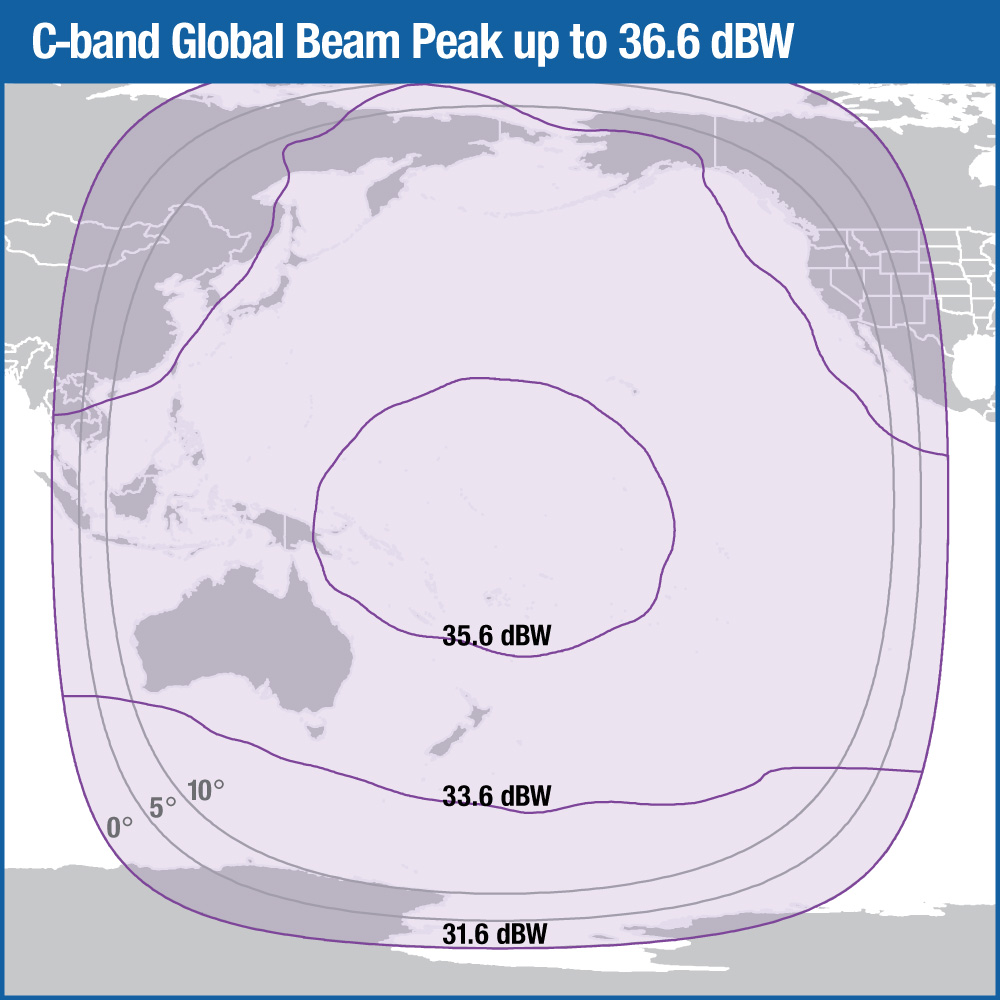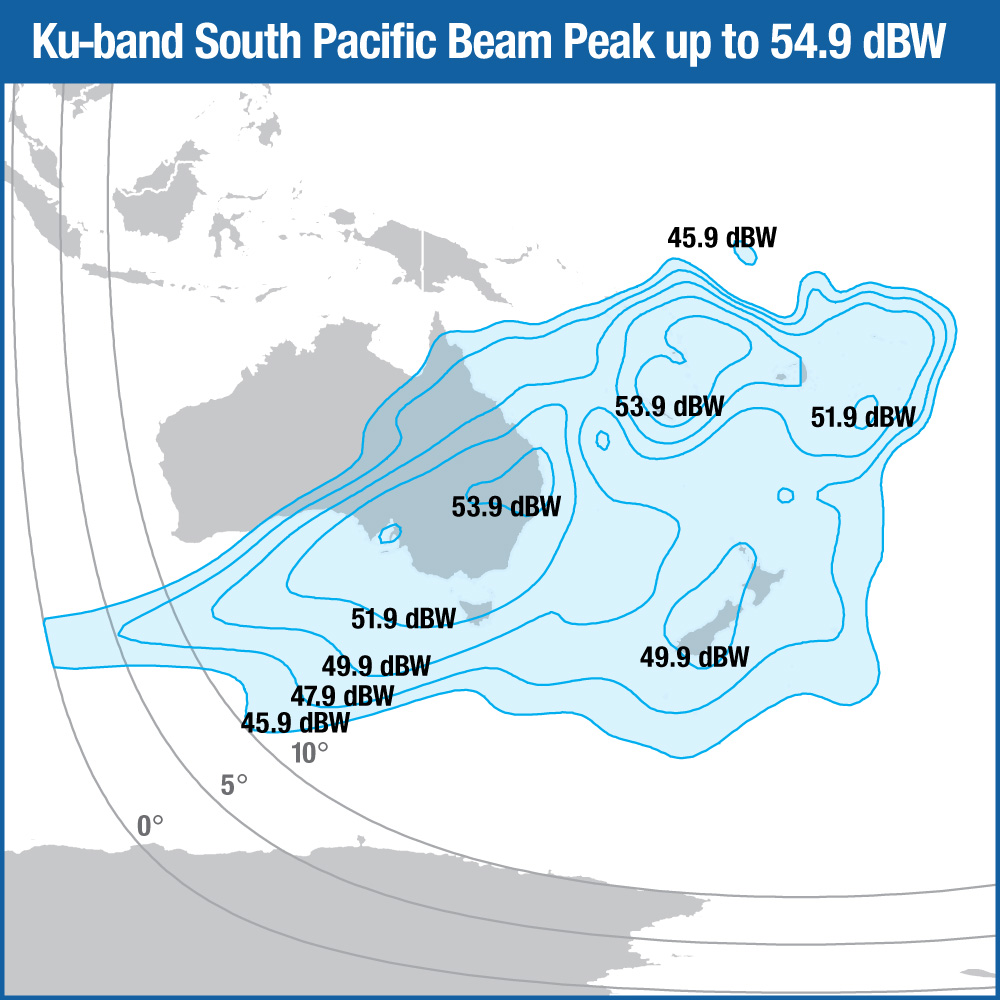Intelsat 18 at 180.0°E covers global territory including North and South Hemi Beam, French Polynesia, and the South Pacific Territory.
General Data
Satellite Name: Intelsat 18 (IS-18)
Status: Active
Position: 180° E (180° E)
NORAD: 37834
Cospar ID: 2011-056A
Official Website: Click on the Spot Beam images to visit the official website
Launch date: 6 Oct 2011
About: Scroll to the bottom of the page for more satellite details
Launch vehicle: Zenit 3SL
Launch mass (kg): 3200
Dry mass (kg): 1464
Manufacturer: Northrop Grumman
Model of the Satellite: GEOS
Orbit: GEO
Spot Beams
For the C Band:
Riverside Teleport: 16.4m
Kumsan Teleport: 13m
Brewster Teleport: 13.1m
For the Ku Band:
Riverside Teleport: 13.1m
Napa Teleport: 13m
Oxford Falls Teleport: 7.6m
-Watch all sports video news and highlights
-More content on social media
| C Band | ||||||||||||
| 42 dBW | 41 dBW | 40 dBW | 39 dBW | 38 dBW | 37 dBW | 36 dBW | 35 dBW | 34 dBW | 33 dBW | 32 dBW | 31 dBW | 30 dBW |
| 80-100 cm | 90-115 cm | 100-125 cm | 115-145 cm | 125-160 cm | 145-180 cm | 160-200 cm | 180-225 cm | 200-255 cm | 225-285 cm | 255-320 cm | 285-360 cm | 320-400 cm |
| Ku Band | ||||||||||||
| 50 dBW | 49 dBW | 48 dBW | 47 dBW | 46 dBW | 45 dBW | 44 dBW | 43 dBW | 42 dBW | 41 dBW | 40 dBW | 39 dBW | 38 dBW |
| 50-60 cm | 55-65 cm | 60-75 cm | 65-85 cm | 75-95 cm | 85-105 cm | 95-120 cm | 105-135 cm | 120-150 cm | 135-170 cm | 150-190 cm | 170-215 cm | 190-240 cm |
About
The Intelsat 18 satellite, a cornerstone in the realm of global communications and broadcasting, was launched on October 5, 2011. The satellite was launched by an Ariane 5 rocket from the Guiana Space Centre in French Guiana. Intelsat 18 was designed and constructed by Orbital Sciences Corporation. This company is now part of Northrop Grumman and is equipped with both C-band and Ku-band transponders. These transponders facilitate a wide range of services, including broadcasting, broadband, and data communications.
One of the key features of Intelsat 18 is its geostationary position at 180.0°E. This strategic location allows the satellite to maintain a fixed position relative to the Earth. The 180.0°E position is particularly significant because it serves as a prime location for covering the Pacific Ocean region, including parts of Asia, Australia, and the Americas. This broad coverage area makes Intelsat 18 an essential component for communication networks across these regions.
The geostationary orbit of Intelsat 18 means that it orbits the Earth at the same rotational speed as the planet, allowing it to remain stationary over a single longitude. This orbit is ideal for communication satellites as it provides uninterrupted service to ground stations and users within its coverage footprint. This stability is crucial for the delivery of television broadcasting, internet services, and other forms of data communication, ensuring minimal disruption and high reliability.
In the broader context of global communications, Intelsat 18 plays a pivotal role. It supports a variety of applications, from direct-to-home television broadcasting to enterprise connectivity and mobile backhaul. Its ability to provide high-quality, consistent service makes it a valuable asset in the Intelsat fleet, contributing to the seamless flow of information and entertainment across the globe.
Technical Specifications and Capabilities
Intelsat 18, with position at 180.0° East, is a satellite that delivers robust communication services. Its payload has 24 C-band and 12 Ku-band transponders, facilitating a diverse range of transmission capabilities. The C-band transponders are instrumental in providing broad geographical coverage, making them ideal for regions with high rainfall where signal degradation is a concern. On the other hand, the Ku-band transponders offer higher bandwidth, catering to more data-intensive applications such as broadcasting and broadband services.
The satellite operates within specific frequency bands: the C-band transponders function in the 3.7 to 4.2 GHz frequency range for downlinking and 5.925 to 6.425 GHz for uplinking. The Ku-band transponders downlink in the 10.95 to 12.75 GHz range and uplink in the 13.75 to 14.5 GHz range. These frequency bands optimize performance and reduce interference, ensuring reliable and high-quality service delivery.
Power generation for Intelsat 18 passes through advanced solar arrays, which harness solar energy to sustain operations. These arrays are complemented by onboard batteries that store energy, enabling uninterrupted service during periods when the satellite is in the Earth’s shadow. The propulsion system of Intelsat 18 employs both chemical and electric propulsion mechanisms. The chemical propulsion system is used for initial orbit-raising maneuvers, while the electric propulsion provides station-keeping capabilities, ensuring the satellite maintains its precise geostationary position.
Intelsat 18 boasts an expected operational lifespan of 15 years, a testament to its robust design and superior engineering. Unique technological features such as adaptive coding and modulation (ACM) enhance its performance by dynamically adjusting signal parameters based on real-time atmospheric conditions. This adaptability ensures optimal data throughput and reliability, even in adverse weather conditions. Furthermore, the satellite’s advanced thermal management system maintains optimal operating temperatures, contributing to its longevity and consistent performance.
Coverage Area
Intelsat 18, positioned at 180.0°E, serves a vast and diversified geographical area. Its coverage primarily extends across the Asia-Pacific region, including countries such as Australia, New Zealand, Japan, China, and several Pacific Islands. The satellite also reaches parts of Southeast Asia and the western edges of the Americas, ensuring a broad and inclusive service footprint.
The types of services provided by Intelsat 18 are multifaceted, catering to both commercial and governmental needs. One of the primary services is television broadcasting, which includes both Direct-to-Home (DTH) services and support for cable television networks. This enables broadcasters to deliver high-quality television content to millions of households, enhancing the entertainment and information landscape in these regions. The satellite’s capacity to support High Definition (HD) and Ultra High Definition (UHD) broadcasts ensures that viewers receive superior visual experiences.
The services
In addition to television broadcasting, Intelsat 18 plays a crucial role in providing internet services. The satellite supports broadband connectivity, which is particularly valuable in remote and underserved areas where terrestrial infrastructure may be limited or non-existent. By facilitating reliable internet access, Intelsat 18 helps bridge the digital divide, supporting educational initiatives, healthcare services, and economic development.
Data communications is another significant service offered by Intelsat 18. This includes the provision of secure and reliable communication channels for businesses, government agencies, and other organizations. The satellite’s robust infrastructure supports a range of applications such as enterprise networking, disaster recovery, and mobile backhaul. This ensures that critical communications remain uninterrupted, even in challenging environments.
The impact of these services on businesses, governments, and consumers within the coverage area is substantial. Businesses benefit from enhanced connectivity and communication capabilities, enabling them to operate more efficiently and reach new markets. Governments can leverage the satellite’s capabilities for national security, disaster response, and public services. Consumers enjoy improved access to information, entertainment, and essential services, contributing to a higher quality of life.
Future Prospects and Developments
As we look ahead, the future of Intelsat 18 presents a landscape of both exciting opportunities and challenges. With the satellite industry continually evolving, Intelsat 18 is poised to either benefit from or be impacted by various technological advancements. One of the primary considerations is the potential for upgrades or replacements. Given the typical lifespan of geostationary satellites, Intelsat 18, launched in 2011, may soon face decisions regarding its operational longevity. Intelsat might opt for extending its service through technological upgrades, or it might be succeeded by a newer satellite equipped with more advanced capabilities.
In terms of technological advancements, the satellite industry is witnessing significant progress in areas such as high-throughput satellites (HTS), which offer increased bandwidth and improved data transmission rates. The integration of HTS technology could vastly enhance the performance of Intelsat 18’s successors. Moreover, the advent of small satellites and constellations presents an opportunity to complement the services provided by Intelsat 18, ensuring more comprehensive coverage and redundancy.
The Role
Intelsat 18’s role within Intelsat’s broader satellite fleet strategy is mightily important. As part of Intelsat’s global communications infrastructure, it contributes to a network that supports diverse applications, from broadcasting and broadband services to critical communications for maritime and aeronautical sectors. The potential introduction of newer satellites could integrate seamlessly with existing ones, creating a more robust and resilient network. This strategic approach ensures that Intelsat remains competitive in delivering reliable and high-quality services to its global customer base.
Furthermore, regulatory considerations and international collaboration will also shape the future of Intelsat 18. As space becomes increasingly congested, coordination with other satellite operators and adherence to international regulations will be essential to mitigate risks and ensure sustainable space operations. These factors will influence decisions regarding future deployments and operational strategies.
In conclusion, the future of Intelsat 18 is intertwined with technological advancements, strategic planning, and regulatory frameworks. Whether through upgrades or replacements, Intelsat 18 will continue to be a pivotal asset in Intelsat’s mission to provide seamless global communications, adapting to the dynamic landscape of the satellite industry.




